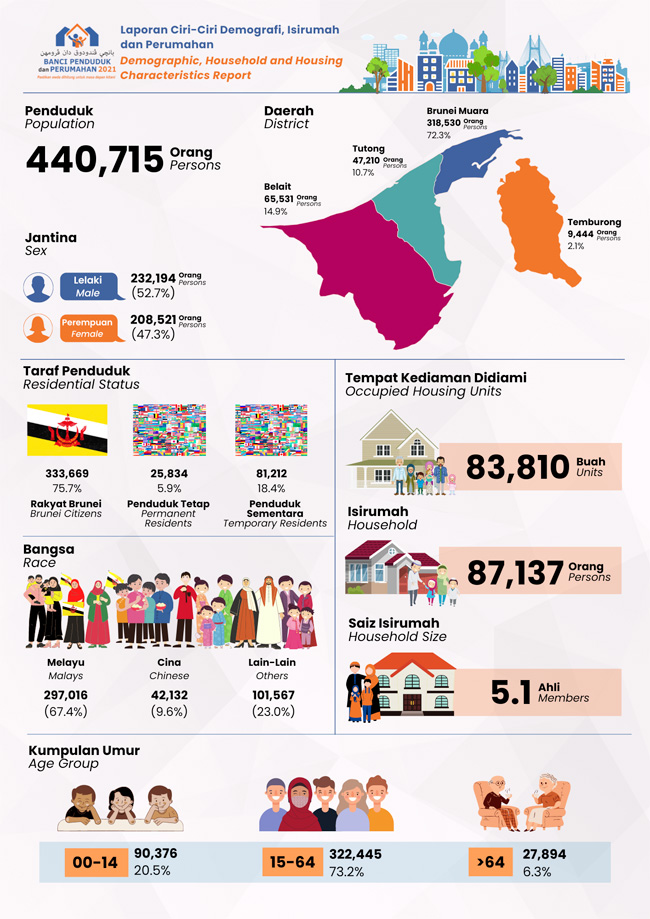The total population of Brunei Darussalam during the Population and Housing Census (BPP) 2021 was 440,715 persons compared to 393,372 in the 2011 Census, which represented an average annual growth rate of 1.1 per cent during the period 2011-2021.
This was revealed in the Department of Economic Planning and Statistics’ (DEPS) Report of the BPP 2021: Demographic, Household and Housing Characteristics based on the final data collected in the BPP 2021. Therefore, this supersedes the data in the Report of the Preliminary Count of Total Population 2021 released in October 2021.
The Government of His Majesty Sultan Haji Hassanal Bolkiah Mu’izzaddin Waddaulah ibni Al-Marhum Sultan Haji Omar ‘Ali Saifuddien Sa’adul Khairi Waddien, Sultan and Yang Di-Pertuan of Brunei Darussalam, through the DEPS conducted the BPP 2021 from January to December 2021.
The main objective was to collect comprehensive and latest information on the total count as well as demographic, social and economic characteristics of the population; as well as on the total number of living quarters with housing characteristics and availability of household amenities. The main findings are:
POPULATION
The population was made up of 232,194 males (52.7 per cent) and 208,521 females (47.3 per cent). The sex ratio was 111 males for every 100 females.
By residential status, Brunei citizens accounted for 75.7 per cent (333,669 persons), while the shares of the permanent residents and temporary residents were 5.9 per cent (25,834 persons) and 18.4 per cent (81,212 persons).


Brunei-Muara District was the most populated district with 72.3 per cent (318,530 persons) of the total population. This was followed by the Belait District (14.9 per cent or 65,531 persons), the Tutong District (10.7 per cent or 47,210 persons) and the Temburong District (2.1 per cent or 9,444 persons).
In age distribution, 20.5 per cent (90,376 persons) of the total population were below 15 years of age, 73.2 per cent (322,445 persons) were in the working age group of 15 to 64 years and 6.3 per cent (27,894 persons) were aged 65 and over. The median age in 2021 was 31.7 years.
The Malays with 67.4 per cent (297,016 persons) of the total population formed the largest community in the country.
The racial groups of Chinese and others comprised 9.6 per cent (42,132 persons) and 23.0 per cent (101,567 persons).
Majority of the country’s population were Muslims, comprising 82.1 per cent (362,035 persons).
More than half (55.4 per cent or 193,965 persons) of the total population aged 15 and over were married, while 38.5 per cent (135,137 persons) were still single. More than three-quarters (79.2 per cent or 349,135 persons) of the total population in 2021 were born in Brunei, including 6,699 temporary residents.
The number of foreign-born population was 91,580 persons, accounting for 20.8 per cent of the total population. Out of this number, 18.6 per cent (17,067 persons) were Brunei citizens and permanent residents who were born abroad.
Brunei-Muara District was the most densely populated district with 558 persons per square kilometre (per sq km).
Belait District had only 24 persons per sq km. Tutong District and Temburong District had population density of 40 persons per sq km and seven persons per sq km. Overall, the country was sparsely populated with 76 persons per sq km.
HOUSING AND HOUSEHOLD
The total number of occupied living quarters or housing units in Brunei Darussalam was 83,810 – an increase of 18,417 from the 2011 Census.
Brunei-Muara District had the largest number of housing units at 59,472 housing units (71.0 per cent). The total number of households was 87,137 compared to 68,237 in 2011.
The average household size was 5.1 members.
POPULATION DISTRIBUTION AND GROWTH BY VILLAGE
Population by village showed significant variation during the 2011-2021 period.
The top five with the highest number population were RPN Kampong Panchor, Brunei-Muara District (13,358 persons or three per cent); Kampong Tanah Jambu, Brunei-Muara District (11,695 persons or 2.7 per cent); Kampong Panaga, Belait District (10,301 persons or 2.3 per cent); Kampong Bukit Beruang, Tutong District (9,835 persons or 2.2 per cent); and Kampong Meragang, Brunei-Muara District (9,190 persons or 2.1 per cent).
The top five in population growth rates were: Kampong Sabun, Brunei-Muara District (10.4 per cent); Kampong Lugu, Brunei-Muara District (10.2 per cent); RPN Kampong Lumut Zone 2, Belait District (7.8 per cent); RPN Kampong Panchor, Brunei-Muara District (5.2 per cent); and Kampong Sengkurong ‘B’, Brunei-Muara District (4.8 per cent).
One factor contributing to the high population growth rates in the villages were the increase in the population in the resettlement areas.
The mid-year population estimates released for the years 2017 to 2020 have now been revised using the latest data.
This information will be published in the Brunei Darussalam Statistical Yearbook (BDSYB) 2021.
The Report of the BPP 2021: Demographic, Household and Housing Characteristics is available from the DEPS’ website.


